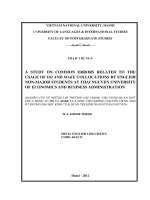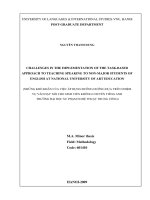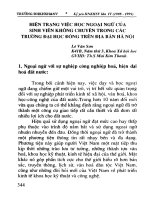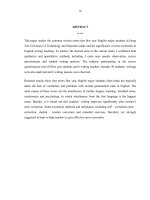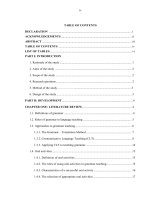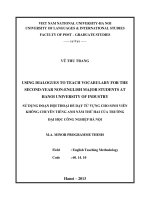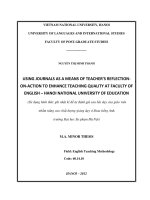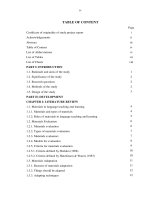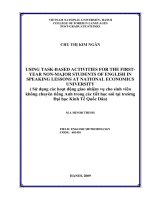NHỮNG KHÓ KHĂN CỦA VIỆC ÁP DỤNG ĐƯỜNG HƯỚNG DỰA TRÊN NHIỆM VỤ VÀO DẠY NÓI CHO SINH VIÊN KHÔNG CHUYÊN TIẾNG ANH TRƯỜNG ĐẠI HỌC SƯ PHẠM NGHỆ THUẬT TRUNG ƯƠNG = challenges in the implementation of the task-based approach to teaching speaking to non-major st
Bạn đang xem bản rút gọn của tài liệu. Xem và tải ngay bản đầy đủ của tài liệu tại đây (941.86 KB, 68 trang )
UNIVERSITY OF LANGUAGES & INTERNATIONAL STUDIES-VNU, HANOI
POST-GRADUATE DEPARTMENT
NGUYỄN THANH DUNG
CHALLENGES IN THE IMPLEMENTATION OF THE TASK-BASED
APPROACH TO TEACHING SPEAKING TO NON-MAJOR STUDENTS OF
ENGLISH AT NATIONAL UNIVERSITY OF ART EDUCATION
(NHỮNG KHÓ KHĂN CỦA VIỆC ÁP DỤNG ĐƯỜNG HƯỚNG DỰA TRÊN NHIỆM
VỤ VÀO DẠY NÓI CHO SINH VIÊN KHÔNG CHUYÊN TIẾNG ANH
TRƯỜNG ĐẠI HỌC SƯ PHẠM NGHỆ THUẬT TRUNG ƯƠNG)
M.A. Minor thesis
Field: Methodology
Code: 601410
HANOI-2009
UNIVERSITY OF LANGUAGES & INTERNATIONAL STUDIES-VNU, HANOI
POST-GRADUATE DEPARTMENT
NGUYỄN THANH DUNG
CHALLENGES IN THE IMPLEMENTATION OF THE TASK-BASED
APPROACH TO TEACHING SPEAKING TO NON-MAJOR STUDENTS OF
ENGLISH AT NATIONAL UNIVERSITY OF ART EDUCATION
(NHỮNG KHÓ KHĂN CỦA VIỆC ÁP DỤNG ĐƯỜNG HƯỚNG DỰA TRÊN NHIỆM
VỤ VÀO DẠY NÓI CHO SINH VIÊN KHÔNG CHUYÊN TIẾNG ANH
TRƯỜNG ĐẠI HỌC SƯ PHẠM NGHỆ THUẬT TRUNG ƯƠNG)
M.A. Minor thesis
Field: Methodology
Code: 601410
Supervisor: Prof. Dr. Hoàng Văn Vân
HANOI-2009
iv
CONTENTS
Page
Declaration
i
Acknowledgements
ii
Abstract
iii
Table of contents
iv
List of abbreviation
v
List of tables
viii
PART A: INTRODUCTION
1
1. Rationale of the study
1
2. Aims and research questions of the study
2
3. Methods of the study
2
4. Scope of the study
2
5. Significance of the study
2
6. Design of the study
3
PART B: DEVELOPMENT
4
Chapter 1: Literature review
4
1.1. Definition of Task-based language teaching
4
1.2. Definition of task within Task-based language teaching
5
1.3. Criterial features of task within Task-based language teaching
6
1.4. Types of tasks within Task-based language teaching
7
1.5. The principles of Task-based language teaching
8
1.6. The framework for Task-based instruction
9
1.7. The role of teacher and learner in Task-based language teaching
12
1.8. The strengths of Task-based language teaching
13
1.9. Previous studies related to applying Task-based language teaching
14
1.9.1. In Hongkong
14
1.9.2. In Vietnam
14
Chapter 2: Current situation of English teaching and learning at NUAE
17
2.1. Description of students
17
v
2.2. Description of teachers
17
2.3. Description of the teaching facilities and the teaching materials
18
2.4. Description of the objective and the time allocation of the English
course
18
2.5. Description of the current method of teaching English
19
Chapter 3: Challenges in the implementation of the Task-based approach to
teaching speaking to students at NUAE
21
3.1. The challenges perceived from contrasting the literature of the Task-based
approach with the current English teaching and learning at NUAE
21
3.1.1. Lack of appropriate teaching conditions
21
3.1.2. Lack of Task-based teaching materials
22
3.1.3. Students’ lack of active role
22
3.1.4. Teacher’s lack of high level of creativity
22
3.2. The challenges perceived by teachers and students after trial task-based
speaking lessons
23
3.2.1. The subjects
23
3.2.2. Instruments for data collection
24
3.2.3. Statistical procedures
24
3.2.4. Procedures
25
3.2.5. Data analysis
25
3.2.5.1. Analysis of questionnaire
25
3.2.5.2. Analysis of the classroom observation
29
3.2.5.3. Analysis of the interview
30
3.2.6. Fidings and discussions
33
3.2.6.1. Inappropriate teaching condition
33
3.2.6.2. Inappropriate teaching material
33
3.2.6.3. Students’ low English proficiency
34
3.2.6.4. Students’ resistance in engaging in tasks
34
3.2.6.5. Students’ overuse of mother tongue during tasks
35
3.3. Recommendations for the application of the Task-based approach to
teaching speaking at NUAE
35
vi
PART C: CONCLUSION
39
1. Summary of the study
39
2. Limitations of the study
40
3. Suggestions for further study
40
References
41
Appendix I
I
Appendix II
VIII
Appendix III
X
Appendix IV
XII
Appendix V
XIII
Appendix VI
XV
vii
LIST OF ABBREVIATIONS
M.A: Master of Arts
NUAE: National University of Art Education
TBA: Task-based approach
TBLT: Task-based language teaching
viii
LIST OF TABLES
Page
Table 1: Willis’ model for Task-based instruction
10
Table 2: Students’ reasons for not involving in speaking tasks
26
Table 3: Students’ difficulty in working in multi-level groups during speaking tasks
26
Table 4: Students’ difficulty in understanding teacher ’s instruction in English
27
Table 5: Students’ difficulty in using the target language to complete speaking tasks
28
Table 6: Students’ reasons for using mother tongue during speaking tasks
28
1
PART A: INTRODUCTION
This part will present the rationale of the study, the aims and the research questions
of the study, the method of the study, the scope of the study, the significance of the study
and the design of the study.
1. Rationale of the study
Task-based language teaching (TBLT), which was first developed in India by N.S
Prabhu in the 1980s, has been a keen contemporary interest in English language teaching
field. The emphasis of TBLT is on communicative learning and teaching of language.
According to Swain (1995), tasks provide input to learners and opportunities for
meaningful language use, both of which are generally considered valuable in promoting
language acquisition. Students can become fully in fufiling tasks, which can reduce tedium
and make class work more challenging and relevant to their interests. Richards and
Rodgers (2001:228) suggest that “Tasks are believed to foster processes of negotiation,
modification, rephrasing, and experiment that are heart of second language learning”.
According to them, practical and relevant tasks can draw the interest of learners and
challenge them sufficiently to get them to use the English they already knew and
incorporate new language items provided by input and the teacher.
In theory, TBLT may bring in certain advantages to English classrooms, and this has
been proved by studies on the application of TBLT in classrooms in Western countries,
where students have greater exposure to real English outside the classrooms. In non-
English speaking countries such as in Vietnam, English language teachers have been
introduced this approach to teaching in teacher in-service workshops or other professional
events. However, it is not sure how many teachers have ever tried out this approach and
how effective it is, because very few impirical researches on TBLT with Vietnamese
students have been done. Up to now, there have not any researches on the application of
TBLT with the students in my teaching context - National University of Art Education
(NUAE). The above gaps concerned me much and inspired me to conduct this study
aiming at investigating the difficulties of the application of TBLT to teaching oral skill in
my university, which helps create bases for providing appropriate recommendations for
making TBLT applicable to students at NUAE.
2
2. Aims and research questions of the study
The aim of the study is to identify the challenges in the implementation of TBLT to
teaching speaking to students at NUAE and provide recommendations for applying TBLT
to teaching oral skill.
The study seeks to answer these questions:
What are the challenges in the implementation of TBLT to teaching
speaking skill to students at NUAE?
What are the recommendations for applying TBLT to teaching speaking skill?
3. Methods of the study
To attain the aim of the study, the researcher employed both quantitative and
qualitative methods combining with the aid of the following research instruments:
- Questionnaire
- Interview
- Classroom observation
Quantitative method was employed to analyze the information collected from the
questionnaire. Qualitative method was used to analyze the interview and the observation.
4. Scope of the study
The study involves 103 first-year students from two classes including one class of
Music Department and one class of Fine-Art Department and two teachers of English at
NUAE. In the scope of a minor thesis, the researcher only focuses on investigating the
challenges in the implementation of TBLT to teaching speaking skill to the first-year
students at NUAE.
5. Significance of the study
The result of the study will provide useful theory of TBLT as one of the innovative
methods for the choices of English teachers at NUAE. The investigation of the difficulties
of the application of TBLT to teaching speaking skill to students at NUAE helps to give
recommendations for the adoption of TBLT to oral lessons. In addition, the identified
challenges in the implementation of TBLT in this study will be a reference for teachers in
similar teaching contexts to consider the applicability of this approach.
3
6. Design of the study
Apart from the introduction and the conclusion, the study consists of three chapters.
The introduction presents an overview of the study including the rationale of the study, the
aim of the study, the scope of the study, the research method, the significance of the study
and the design of the study.
Chapter 1 provides the theoretical background for the study and identifies the
“gaps” in the research to date, which the researcher hopes to at least partially fill.
Chapter 2 describes the current situation of English teaching and learning at NUAE.
Chapter 3 identifies the perceived challenges in the implementation of TBLT to
English speaking lessons at NUAE. This was done by contrasting the literature of TBLT
and the current English teaching situation at NUAE and by conducting questionnaires with
students and interviews with teachers after trial period combining with classroom
observation. Then some recommendations for applying TBLT to teaching speaking skill
are also given in this chapter.
The conclusion summarizes the main points of the study, presents the limitations of
the study, and gives suggestions for further research.
4
PART B: DEVELOPMENT
CHAPTER 1
LITERATURE REVIEW
This chapter will deal with the relevant theoretical background for the study
including the definition of TBLT, the definitions of task in TBLT, the features of a task,
the types of tasks, the principles of TBLT, the framework for Task-based instruction, the
roles of the teacher and the learner in TBLT, the strengths of TBLT and the previous
studies on TBLT.
1.1. Definition of Task-based language teaching
TBLT has been advocated by many researchers and teachers around the world, but
“What is TBLT?” still needs clarification. Richards and Rogers (2001), for example, give a
clear and simple definition of TBLT. According to them, TBLT is “an approach based on
the use of tasks as the core unit of planning and instruction in language teaching”. Larsen-
Freeman (2000), on the other hand, sees TBLT as an approach seeking to provide learners
with a natural context to language use. As learners work to complete a task, they have
abundant opportunity to interact. Such interaction is thought to facilitate language
acquisition as learners have to work to understand each other and to express their own
meaning. In their definitions Richards and Rogers and Larsen-Freeman mention the term
“task”. This term is not new to teachers as well as practioners around the world, since tasks
have been used in classes for hundreds of years. For instance, asking students to do a
grammar exercise is also called a task. So what is the difference here? The difference
between TBLT and other traditional approaches lies in the way in which the goal is
achieved. In TBLT, tasks are always activities where the target language is used for a
communicative purpose in order to achieve an outcome in which the emphasis is on
exchanging meaning not producing language forms. Therefore, the characteristic of all the
tasks in the new approach is that rather than concentrating on one particular structure,
function, or vocabulary group, these tasks cover a wide range of language. In TBLT, the
tasks are central to the learning and teaching activity. It is based on the belief that students
can learn more effectively when their minds are focused on the task, rather than on the
language they are using. Learning to speak and to understand a language automatically in a
5
vast variety of situations requires intensive exposure to language and unlimited interaction
with language users. Because tasks are basic units of a TBLT framework, it is crucial to
clarify explicitly the concepts of task.
1.2. Definition of task within Task-based language teaching
Tasks are defined differently by different second language researchers and linguits
depending on the scope and perspectives.
Long (1985) defined a task as “a piece of work undertaken for oneself or for others,
freely or for some award. Thus, examples of tasks include painting a fence, dressing a
child, filling out a form, buying a pair of shoes, making an airline reservation, borrowing a
library book, taking a driving test, typing a letter, weighing a patient, sorting letters,
making a hotel reservation, writing a check, finding a street destination and helping
someone cross the road” (p.89). Pedagogically, Long ’s above definition of a task does not
involve much in language teaching and learning, since tasks which are used in language
classrooms need to make a contribution to developing communicative abilities. Task in
Long ’s definition can be related to tasks that both use and do not use language. Some
researchers were not satisfied with Long ’s definition and they tried to relate a task to the
language pedagogy. Nunan (2005) argues that Long ’s definition of task does not
necesarrily involve language use. As a result, a variety of definitions of tasks were
introduced by researchers and linguists.
Breen (1987) defines task from the pedagogical perspective: “ any structure
language learning endeavour which has a particular objective, appropriate content, a
specified working procedure, and a range of outcomes for those who undertake the task.
‘Task’ is therefore assumed to refer to a range of workplans which have the overall
purposes of facilitating language learning - from the simple and brief exercise, to more
complex and lengthy activities such as problem solving and decision making” (p.23).
According to Breen, all kinds of activities involving language learning are regarded as
tasks.
In Jane Willis’ definition (1996), “Task is an activity in which the target language
is used by learners for a communicative purpose in order to achieve an outcome”. Jane
Willis’ point in her definition is that the communicative purpose is given to the priority and
that learners learn a language through undertaking the task. That is, learners are given
opportunities to explore new language through doing tasks.
6
Skehan (1996b) sees tasks as “activities which have meaning as their primary focus.
Success in tasks is evaluated in terms of achievement of an outcome, and tasks generally
bear some resemblance to real life language use. So Task-based instruction takes a fairly
strong view of communicative language teaching” (p.20).
Nunan (1989) defines a task as follows: “The communicative task [is] a piece of
classroom work which involves learners in comprehending, manipulating, producing or
interacting in the target language while their attention is principally focused on meaning
rather than form. The task should have a sense of completeness, being able to stand alone
as a communicative act in its own right”. Nunan’s (1989) definition emphasizes the
pedagogical tasks’ involvement in communicative language use. Nunan views tasks as
being different from grammatical exercises, because a task involves achieving an outcome.
Bygate (2001) claims that task should be defined more clearly and can be applied to
different contexts. Stemming from this idea, he defined “A task is an activity which
requires learners to use language with emphasis on meaning to attain an objective, and
which is chosen so that it is most likely to provide information for learners which help
them evaluate their own learning” (p.11).
Although the above mentioned definitions of tasks are defined differently, they
share the common feature that a task involves a focus on meaning rather than form.
Another common characteristic underlying these definitions is the purposefulness of the
task. That is, a task must have clear aims which are set to help learners to manipulate to
achieve an outcome. Besides, the common slogan in these definitions is using tasks for
communicative purposes. So the tasks used in Task-based classes must be carefully
selected to meet that slogan.
I define tasks as classroom activities designed for learners to experience the
information exchange and meaning negotiation processes using the target language to
achieve an outcome. In my opinion, tasks are a central component of TBLT in language
classrooms, since tasks create a context that activates learning processes and helps to
promote second language learning.
1.3. Criterial features of tasks within Task-based language teaching
Defining the features of a task in TBLT is of great importance, because this helps to
distinguish tasks in TBLT from other tasks. In her definition of a task in TBLT, Jane Willis
7
(1996) defines a task as “an activity”, and she gave the criterial features of a task by
raising questions as follows:
Does the activity engage learners’ interest?
Is there a primary focus on meaning?
Is there an outcome?
Is success judged in terms of outcome? Is completion a priority?
Does the activity relate to real world activities?
Jane Willis’ criterial features of a task help to provide teachers with guidelines for
the design of activities which are task-like in that they involve real language. These
defined criterion make it easier for teachers to follow and it is clear that the more
confidently teachers can answer “yes” to each of the above questions the more task-like the
activity is.
1.4. Types of tasks within Task-based language teaching
The classification of tasks are different due to the different perspectives of
researchers and linguists. Following are different types of tasks according to the literature.
Pica, Kanagy and Falodun (1993) classify tasks according to the types of
interactions in the product. Their task classification is presented as follows:
Jigsaw tasks: These involves learners combining different pieces of information to
form a whole (e.g, three individuals or groups may have three different parts of a story and
have to piece the story together).
Information-gap tasks: One student or group of students has one set of information
and another student or group has a complementary set of information. They must negotiate
and find out what the other party’s information is in order to complete an activity.
Problem-solving task: Students are given a problem and a set of information. They
must arrive at a solution to the problem.
Decision-making tasks: Students are given a problem for which there are a number
of outcomes and they must choose one through negotion and discussion.
Opinion exchange tasks: Students engage in discussion and exchange of ideas.
They do not need to reach an agreement.
According to Willis (1996), there are six types of tasks: listing, ordering and sorting,
comparing, problem solving, sharing personal experiences and creative tasks.
8
Richards (2001) distinguishes tasks into two types – pedagogical tasks and real
world tasks. “ Pedagogical tasks are based on second language acquisition theory and are
designed to trigger second language learning process and strategies” (p.162). Examples of
pedagogical tasks are jigsaw tasks, information-gap tasks, problem solving tasks, decision -
making tasks and opinion exchange tasks. According to Richards (2001), real world tasks
“are designed to practice or rehearse those activities that are found to be important in a
needs analysis and that turn out to be important and useful in the real world” (p.162).
1.5. The principles of TBLT
Researchers have tried to establish the principles of TBLT (Willis, 1996; Skehan,
1998; Nunan, 1989). Ellis (2003) synthesizes eight principles of TBLT as follows:
First, setting an appropriate level of task difficulty. To do this, teachers can adjust
the difficulty of a task methodologically, for example, by incorporating a pre-task phase
into the lesson, by appropriate use of talk, or by choosing to perform the task with students
in the form of an instructional conversation.
Second, establishing clear goals for each task-based lesson. This means
methodological options can be selected to help prioritize different language aspects of
language use, for example, fluencey vs. accuracy.
Third, developing an appropriate orientation to performing the task in students.
That is, students need to be aware of why they are being asked to perform tasks. They need
to treat them seriously, not just as “fun”.
Fourth, ensuring that students adopt an active role in task-based lessons. One of the
major goals of TBLT is to provide learners with an opportunity to participate fully by
playing an initiating as well as a responding role in classroom discourse. So a key element
of being “active” is negotiating meaning when communicative problem arise. One of the
principal ways of ensuring this is through group or pair work.
Fifth, encouraging students to take risks. When students perform tasks they need to
“stretch” their interlanguage resources. This requires students to be prepared to experiment
with language. According to Ellis (2001), methodological choices that encourage the use of
private speech when performing a task, that create opportunities for “pushed output”, and
that help to create an appropriate level of challenge in an affective climate that is
supporting risk-taking will assist this.
9
Sixth, ensuring that students are primarily focused on meaning when they perform
a task. The main purpose of a task is to provide a context for processing language, i.e. by
treating language as a tool not as an object. Thus, when students perform a task they must
be primarily concerned with achieving an outcome, not with displaying language. This can
only be achieved if learners are motivated to do the task.
Like Willis (1996) and Skehan (1998b), in his seventh principle of TBLT, Ellis
suggested that a task provide opportunities for focusing on form. This can be done at
various options such as at the pre-task, during-task, and post-task phases of a task-based
lesson.
The last principle of TBLT is to require students to evaluate their performance and
progress. A task-based lesson needs to engage and help to foster metacognitive awareness
in students.
To summarize, the obove mentioned principles of TBLT are intended as a general
guide to the teaching of task-based lessons, which are useful for teachers to design
effective task-based lessons.
1.6. The framework for Task-based instruction
The design of a task-based lesson involves consideration of the stages or
components of a lesson that has a task as its principal component. Various designs have
been proposed (for example, Prabhu 1987; Estaire and Zanon 1994; Skehan 1996; Willis
1996; Lee 2000). However, they all have in common three principal phases: pre-task phase;
during-task phase and post-task phase. Among these suggestions, the framework for Task-
based instruction suggested by Willis (1996), which is presented in table 1 is much more
detailed and has been proved effective.
10
Pre-task
Introduction to topic and tasks
Task cycle
Task
Planning
Report
Language focus
Analysis
Practice
Table 1: Willis’ model for task-based instruction (Willis 1996: 52)
As it can be seen in Willis’ model, it is important to consider three stages in the
implementation of the Task-based approach.
The Pre-task stage
In this stage, the teacher helps students to understand the theme and objectives of
the task, for example, brainstorming ideas with the class, using pictures, mime, or personal
experience to introduce the topic. Students may be introduced to the topic through one of
the following ways: (1) supporting learners in performing a task similar to the task they
will perform in the during-task phase of the lesson; (2) asking students to observe a model
of how to perform the task and (3) engaging learners in non-task activities designed to
perform the task. In a task-based lesson, the pre-task activities are of great importance,
which serve as a preparation for performing the main task individually.
The task cycle
In the second stage of task-based instruction, there are sub-phases.
Task:
In this sub-phase, the task is done by students (in pairs or groups), and students are
given a chance to use whatever language they already have to express themselves and say
whatever they want to say. The role of the teacher is to walk round, monitor and encourage
in a supportive way everyone ’s attempts at communication in the target language. Besides,
the teacher helps students to formulate what they want to say, but will not intervene to
11
correct errors of form. The emphasis is on spontaneous, exploratory talk and confidence
building, within the small group.
Planning:
This sub-stage prepares for the next stage, when students are asked to report briefly
to the whole class how they did the task and what the outcome was. In this phase, students
have to draft and rehearse what they want to say or write. The teacher goes round and
advises students on language, suggesting phases and helping students to polish their
language. The emphasis is on clarity, organization, and accuracy, as appropriate for a
public presentation.
Report:
In this stage, the teacher asks some pairs or groups to report briefly to the whole
class so everyone can compare findings, or begins a survey (there must be a purpose for
others to listen). Sometimes only one or two groups report in full, others comment and add
extra points. The class may take notes. The role of the teacher is to chair, comment on the
content of their reports, rephrase perhaps, but give no overt public correction.
Post-task listening
Students listen to a recording of fluent speakers doing the same task, and compare
the ways in which they did the task themselves.
The langage focus stage
The language focus stage consists of two sub-stages: Analysis stage and Practice
stage.
Analysis:
In this stage, the teacher sets some language-focused tasks, based on the texts
students have read or on the transcripts of the recordings they have heard. For example,
asking students to find words and phrases related to the title of the topic or text or read the
transcript to find words ending in “s” and say what the “s” means.
Practice:
In this stage, the teacher conducts practice activities as needed, based on the
language analysis work already on the board, or using examples from the text or transcript.
The practice activities can include choral repetition of the phases identified and classified,
sentence completion or matching the past-tense verbs (jumbled) with the subjects or
objects they had in the text.
12
1.7. The role of teacher and learner in TBLT
The role of the teacher and the learner are interactive and inseparable in language
teaching and learning process. Richards and Rodgers (2001) pointed out the roles of the
teacher in TBLT as follows:
Firstly, the teacher plays as the selector and sequencer of tasks. That is, the central
role of the teacher is in selecting, adapting, and creating the tasks themselves and then
forming these into an instructional sequence in keeping with the learner needs, interests
and language skill level.
In addition, the teacher has to prepare learners for tasks. It is essential that learners
do some sort of pre-task preparation. Such activities might include topic introduction,
clarifying task instruction, helping students learn or recall useful words and phrases to
facilitate task accomplishment, and providing partial demonstration of task procedures.
Lastly, the teacher plays an important role in consciousness-raising. This is referred
to as “Focus on Form” by employing a variety of form-focusing techniques, including
attention-focusing pre-task activities, and use of highlighted material.
As mentioned above, the roles of the teacher and the learner are inseparable.
According to Richards and Rodgers (2001), the learner plays the following roles in TBLT.
In the first place, because many tasks will be done in pairs or small groups. So the
learner will be the group participant. The learner, therefore, needs to be active and
enthusiastic in taking part in the tasks.
Besides, the learner plays the role as a monitor. In TBLT, tasks are not employed
for their own sake but as a means of facilitating learning. Class activities have to be
designed so that students have the opportunity to notice how language is used in
communication. Learners themselves need to “attend” not only the message in task work,
but also to the form in which such messages typically come packed.
Another role of the learner in TBLT is the risk-taker and innovator. Many tasks
will require learners to create and interpret messages for which they lack full linguistic
resources and prior experience. Practice in restating, paraphrasing, using paralinguistic
signals, and so on, will often be needed. The skills of guessing from linguistic and
contexual clues, asking for clarification, and consulting with other learners may also be
needed to be developed.
13
1.8. The strengths of TBLT
Ritchie (2003) suggested that TBLT is better than traditional approaches because
learners are exposed to richer language, namely the comprehensible input. It is believed
that “language acquisition is more creative and dynamic than simple imprinting of target
language utterances” (p.117). The Task-based lesson, with its richer input and
opportunities for analysis of texts, allows learners to notice what they want, need or are
ready to learn – features of discourse and lexis as well as aspects of grammar (p.120).
Ritchie also pointed out that such rich input enhances incidental learning and that input
could become intake in Task-based lesson when students are given the chances to notice
the form, to form hypotheses about the use of this particular form and to conduct an
interpretation activity. The communicative task allows learners to use the languge to
negotiate for meanings, and the value of this type of tasks is to let learners attempt to make
production in which “they have to form hypotheses and make grammatical choices that
encourages ‘noticing gap’” (p.121).
Skehan (1996b) indicated that the strength of TBLT is that it provides learners the
opportunities to make use of lexical resources they have either from previous knowledge or
the pre-task input. Then through interactions or negotiations of meanings, students can
eventually develop greater fluency (p.22).
Conspicuously, researchers of TBLT and those whose support it have tried to give
sound background of TBLT. However, the implementation of TBLT to language
classroom settings is still of great challenges for many teachers. In fact, there has been very
little impirical evidence of the effectiveness of TBLT.
Basing on what has been presented in the literature of TBLT, I think that TBLT
may only be suitable with second language environment where students are exposed to real
English outside the classes, with high proficency language learners who can use their
language repertoire to complete the tasks, and with favourable teaching settings with
appropriate teaching conditions for TBLT. “Does TBLT work in foreign language
environment, with language beginners and in not favourable conditions?” is still a question
that needs to be investigated. That is the reason I did this research to find out whether or
not teachers and students in my teaching context met any challenge when applying TBLT.
14
1.9. Previous studies related to applying TBLT
1.9.1. In Hongkong
Carless (2002) reports a case study of three English teachers implementing Task-
based learning in a Hongkong primary school. His study focuses on four themes –
“noise/indispline, the use of mother tongue, the extent of pupil involvement and the role of
drawing and colouring activities” (p.389).
Carless (2002) pointed out that Task-based research is limited, because focus is
mainly on definitions of tasks, the role of tasks played in language learning, the task cycles,
and the descriptions of task types. Theoretical discussions dominate rather than the
“practical discussion of how tasks are actually implemented in school settings, particularly
where conditions may be less than ideal” (p.389).
In his study, Carless (2002) also pointed out that Task-based language teaching has
many unfavourable factors in Hongkong school “Task-based teaching has not yet fully
established itself and is generally considered – except by younger or more recently trained
teachers – to be innovative. Conditions for Task-based learning are not particularly
favourable” (p.390).
His study indicated that different teachers focused on different aspects in their
teaching. His study identified problems faced by teachers at the primary school in Hong-
kong when implementing TBLT. The first problem is maintaining noise level and well-
disciplined classroom environment. The second problem is the use of mother tongue of
students, which affected language learning process. The third problem is student
involvement. Classroom observations in Task-based lessons showed that during the lessons
many students only sat passively. They kept quiet from the beginning of the lesson to the
end, and they were not interested in the tasks. The last problem is the wide range of ability
among students. As a result, it is difficult to design the tasks that suit the different ability
levels of students in a class.
1.9.2. In Vietnam
Huong (2007) conducts an experimental research on the benefits of implementing a
task-based approach in teaching speaking to the third-year students of Business
Administration Department, Trade Union University. Her study was done with two groups
of students. One group is the control group and the other is the experimental group.
Conventional method of teaching was used with the control group in the speaking lesson.
15
TBLT was employed in the experimental group. To evaluate the effectiveness of TBLT on
speaking skill of students, Huong conducted a pre-speaking test and a post-speaking test
with both groups. Then she compared the students’ scores in the pre-test and the ones in
the post-test. In her study, Huong pointed out that there was a significant difference in
students’ achievement on the oral tests and that students of the experimental group showed
a much better result after the experimental semester. Besides, Huong also conducted a
semi-structured interview with students at the end of the course to investigate their
attitudes towards TBLT. She indicated that most of the students interviewed had positive
points of view about TBLT.
The two mentioned previous studies on the implementation of TBLT raised
questions for the author of this research. The problems of the implementation of TBLT
faced by primary teachers in Hong Kong made the author refer to Vietnamese context.
Because Hongkong and Vietnam are both located in Asia, so they have some general
characteristics in culture and in educational system. Besides, Hongkong and Vietnam are
non-English speaking countries, where mother tongue has a dominant role, and students do
not have many opportunities of being exposed to English. So one question raised is “Are
there any obstacles of the application of TBLT to English classrooms in Vietnamese
teaching context?”. With the second case, Huong (2007) only investigated one side of
TBLT – the benefits. Her study did not mention the other side of TBLT – the problems of
the implementation encountered by Vietnamese teachers and students. In addition, her
experimental study was conducted with the third-year students whose English proficiency
was at intermediate level and they were much motivated in learning English for using it in
their future jobs. It is wondered whether or not TBLT is feasible with students with low
English proficency like the ones in my own teaching context. For those reasons, I did this
study with the hope of partially filling the above gaps.
Summary
This chapter clarified what TBLT is and the difference between TBLT and
traditional language approaches. The different types of tasks within TBLT, the principles
of TBLT, the framework for conducting tasks in TBLT, the roles of the teacher and the
learner in a task-based lesson were reviewed as well. The “gaps” in the previous researches,
which the author of this study wants to partially fill, were also pointed out in this chapter.
All of the above mentioned issues provide the researcher of this study with a full
16
understading of TBLT, which helps her to constrast the literature of TBLT with her current
teaching context to identify the mismatches. The identified mismatches between the theory
of TBLT and the practice of teaching context are the challenges for both teachers and
students when working with TBLT.
17
CHAPTER 2
CURRENT SITUATION OF ENGLISH TEACHING AND LEARNING AT
NATIONAL UNIVERSITY OF ART EDUCATION
This chapter provides information on the teaching context including the students,
the teachers, the teaching materials, the physical setting and the teaching and learning
activities at NUAE. The information, which is collected from the existing data files and
from classroom observations, is very useful for the researcher to contrast it with the
literature of TBLT in order to identify the mismatches between the theory and practice.
2.1. Description of students
This session discusses the characteristics of students at NUAE, who have great
influence on the process of teaching and learning. They all have passed a challenging
University Entrance Examination with other subjects except for English. They are both
male and female coming from different parts - from big cities to rural and mountainous
areas of Vietnam. Some of them have learned English for 7 years at high school. Some
have never learned English before, since at high school they learned other foreign
languages such as French or Russian. But the majority of them have 3 years of learning
English.
From the experience of teaching, I find the fact that some fresh students appear to
be better ones in class, but they are only good at grammar. They can do written grammar
exercises accurately, but they are unable to speak English in everyday conversations.
2.2. Description of teacher
In the teaching and learning renovation, the teacher always plays a very important
role. It is the teacher who makes a great contribution to a high quality education. It is,
therefore, crucial that teachers be well-qualified. At NUAE, there are 6 teachers of English
(four of them are full-time teachers, one is a part-time teacher). Two of the English
teachers were trained in the English in-service training courses. These two teachers used to
be teachers of Russian. Since Russian is no longer taught at NUAE, they have to teach
English. Among 5 teachers, only one has completed an MA programme, two are doing an
18
MA programme. The majority of them have bachelor degrees. All English teachers at
NUAE are non-native speakers and they have never been to any English speaking
countries and their opportunities of speaking and working with native speakers are rare.
Moreover, teachers are rarely given opportunities of joining professional development
events such as seminars or conferences on language teaching.
2.3. Description of the teaching facilities and the teaching materials
Classroom arrangement: At NUAE all of the classrooms are designed for lecture
lessons. It means that the seating is arranged orderly in front of teachers, students and the
blackboard. Most of the English lessons are conducted in such a fixed condition, which
prevents teachers from making a change in adopting new ideas in language teaching. In
addition, the classes are too small for the number of students in each.
The class size: The size of almost English classes is big with around 50 and even 57
in each.
The teaching aids: No English classroom is equipped with an overhead projector.
So it is impossible for teachers to bring the advantages of information technology to
language teaching. The English Division has only one television and three cassette players.
This number is not enough for use on the day when many teachers have English lessons at
the same time.
The materials: The current English teaching textbooks are Lifeline Elementary and
Lifeline Pre-intermediate. The English materials for reference and for self-study are not
available in the library at NUAE. The researcher of this study at times go to explore the
university library and find that there are only few old English textbooks. Almost all the
materials are about music and fine-arts.
2.4. Description of the objective and the time allocation of the English course
The objective of the course:
The requirements in English for graduate students at NUAE as stated in the
syllabus are as follows:
Students are equipped with a basic English knowledge of grammar and vocabulary.
After finishing the course, students are able to use the target language to
communicate with foreigners in everyday situations.
